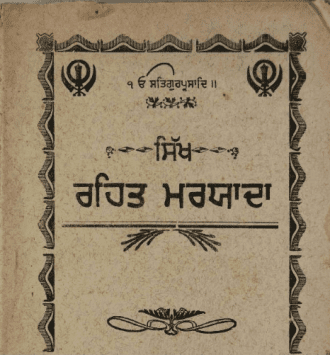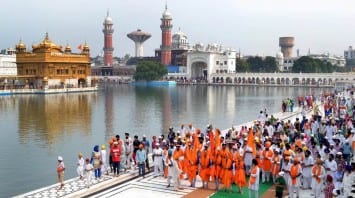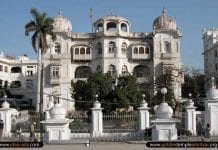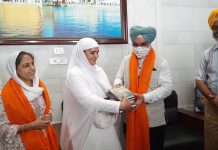It was once universally recognized that the Shiromani Akali Dal (SAD) was the indisputable political wing of the modern day Sikh movement. When India was partitioned in 1947, having abandoned the idea of an independent (Azad) Punjab, the SAD under the leadership of Master Tara Singh, fatally, it sided the Indian National Congress (INC). Given that the INC professed to be committed to an inclusive, democratic and secular system an given the public declaration made by made by Jawaharlal Nehru on 4 April 1946, that he was committed to enable Sikhs “to have a semi-autonomous unit within the province so that they may experience the glow of freedom“, then this was probably a logical decision.
The fact that millions of people in Delhi elected a party that has openly sided with the Sikh cause whilst totally rejecting both the deeply corrupt Congress and the Hinduva inspired BJP/RSS/Akali alliance is noteworthy.


 If we fast forward to 1984 and a decade of persecution of Sikhs resulting in the destruction of the Darbar Sahib, the Delhi Sikh Genocide andextra judicial murder of over 100,000 Sikhs in so-called fake police encounters, history will record the decision to trust the Congress as a total disaster. But after 30 years of struggling for justice, finally, the historical landslide victory of Arvind Kejarival’s Aam Adami Party (AAP) in Delhi following the amazing success that AAP had in Punjab during the recent national elections, perhaps the nightmare is finally over. Millions of Sikhs across the world are now looking to Kejarival to deliver on his promises of justice for Sikhs. The fact that millions of people in Delhi elected a party that has openly sided with the Sikh cause whilst totally rejecting both the deeply corrupt Congress and the Hinduva inspired BJP/RSS/Akali alliance is noteworthy. It is a clear message that the ordinary people of India, the ‘aam adamis’ are not our enemies, [the real enemy is] but the ruling elites, be they Mr. Modi, Mr. Gandhi or Mr. Badal. The AAP victory has exposed and given dramatic expression to what most ordinary people knew, namely that the country had become hijacked by an 3 way alliance of criminal ‘politicians’, criminal gangs, and criminal god-men.
If we fast forward to 1984 and a decade of persecution of Sikhs resulting in the destruction of the Darbar Sahib, the Delhi Sikh Genocide andextra judicial murder of over 100,000 Sikhs in so-called fake police encounters, history will record the decision to trust the Congress as a total disaster. But after 30 years of struggling for justice, finally, the historical landslide victory of Arvind Kejarival’s Aam Adami Party (AAP) in Delhi following the amazing success that AAP had in Punjab during the recent national elections, perhaps the nightmare is finally over. Millions of Sikhs across the world are now looking to Kejarival to deliver on his promises of justice for Sikhs. The fact that millions of people in Delhi elected a party that has openly sided with the Sikh cause whilst totally rejecting both the deeply corrupt Congress and the Hinduva inspired BJP/RSS/Akali alliance is noteworthy. It is a clear message that the ordinary people of India, the ‘aam adamis’ are not our enemies, [the real enemy is] but the ruling elites, be they Mr. Modi, Mr. Gandhi or Mr. Badal. The AAP victory has exposed and given dramatic expression to what most ordinary people knew, namely that the country had become hijacked by an 3 way alliance of criminal ‘politicians’, criminal gangs, and criminal god-men.
It is said that history repeats itself and in some senses, certainly from a Sikh perspective the death of Congress and the rise of AAP has parallels with the shift of power from the Moghul Emperor Aurangzeb to Bahadur Shah’s. Whereas Aurangzeb was hell bent on eliminating the Sikhs, Bahadur Shah sought peace and reconciliation. Though some cynics are suggesting the AAP is simply the next incarnation of the Congress, the truth is that if one looks at the credentials of their candidates and elected officials, they do not represent a political elite; they are truly ordinary people with extraordinary visions for a country that under the concept of ‘swaraj’ is ruled by the people for the people, one that is free from corruption and injustice, that protects the vulnerable and weak from oppression.
But perhaps the most significant fact of the AAP victory is the utter rejection of the murderous fascistic Hindutva inspired ideology of ‘ghar vapsi’ or the forced conversions of all those deemed to be non-Hindus ‘back to the fold’ of Hinduism. Sikhs are told it does not impact them because under the Indian constitution, along with Jains and Budhists, they are already regarded as Hindus! We must not forget that though we have the light of AAP shining in Delhi across the country, the BJP rules and the policy of is being implemented without any slackening off.
And so the question facing Sikhs remains, how can we survive in what appears to be an increasing hostile world? One thing is for sure, as a rapidly globalized community, our future probably does NOT lie in Punjab or Punjabi culture. There are a number of factors, which leads one to come to this conclusion. First, based on the last census, the proportion of Sikhs in Punjab has been rapidly declining and it is predicted to dip from the current 60% to below 50% within the next 20 years. Second, especially amongst the Sikh heartlands of Majha and Malva, we are seeing a dramatic rise in conversions, particularly amongst Dalit Sikhs, to other faiths. Third, the rapid rise of sects (deras) is leading to fragmentation of Sikh communities. Fourth, due to rapid increase in drugs and alcohol addiction, coupled with the poisoning of the water supply, dramatic decrease in fertility levels. And last and perhaps most significantly, there continues to be a rapid exodus of Sikhs from Punjab to Europe, North America, the Middle East and Australasia.
As a minority community that from its inception has been under constant threat, be they Moghuls, the British and now the Hindus, Sikhs have always been confronted with the question of survival. I am not normally an advocate of the Darwinian mantra of ‘survival of the fittest’ but one cannot deny there is a truism here. Ultimately for Sikhs, as we spread across the world, this will mean that we will need to tolerate plurality within Sikhi, or at least find a way of meshing into different cultural contexts. That does not mean that we should do away with fundamental Sikh tenants, but it does mean we need to separate out what might be the universal tenants of Sikhi and the local cultural expression of this.


 The good news is that our Gurus have provided us with a very open minded ideology, free from the kinds of rigid laws and rules one finds in, for example, the Islamic Sharia tradition. The Panth Parvanat Rehit Maryada is the first and only attempt by the whole Panth to establish something resembling a set of minimum rules for which it is often criticised for being ‘minimalist’. Actually that was the very purpose of the document, namely, to establish a principled but broad, inclusive conception of Sikhi and who can claim to be a Sikh. What makes it such an impressive document is its progressive stance on social divisions of caste/class, gender and race along with repudiation of rituals and superstitious beliefs. Moreover by versing the authority of the Panth Khalsa in the institution of Panj Piaray, and the wider ‘sarbat khalsa’, Guru Gobind Singh Ji gave the future generations of Sikhs a mechanism for reforming and developing the faith in the light of new ethical, political and theological challenges that may unfold over time and space.
The good news is that our Gurus have provided us with a very open minded ideology, free from the kinds of rigid laws and rules one finds in, for example, the Islamic Sharia tradition. The Panth Parvanat Rehit Maryada is the first and only attempt by the whole Panth to establish something resembling a set of minimum rules for which it is often criticised for being ‘minimalist’. Actually that was the very purpose of the document, namely, to establish a principled but broad, inclusive conception of Sikhi and who can claim to be a Sikh. What makes it such an impressive document is its progressive stance on social divisions of caste/class, gender and race along with repudiation of rituals and superstitious beliefs. Moreover by versing the authority of the Panth Khalsa in the institution of Panj Piaray, and the wider ‘sarbat khalsa’, Guru Gobind Singh Ji gave the future generations of Sikhs a mechanism for reforming and developing the faith in the light of new ethical, political and theological challenges that may unfold over time and space.
In this regard, we could learn a lot from the oldest faith systems that continue to survive. We could, for example, learn a lot from the recent pronouncement by Pope Francis 1 when he stated that God was not a “magician with a magic wand”, that the Big Bang theory does not contradict the intervention of the divine creator, or that the theory of evolution is nature is not inconsistent with the notion of creation. The Popes intervention is not new; the Church has been for centuries updating their interpretation of faith in the light of the development of knowledge and discovery. The question is, how do we Sikhs respond to the profound discoveries that are being made and the attendant ethical questions they raise? How do we respond to the Pope’s rejection of a God that is only valid if he is seen to be capable of performing miracles?
Actually, the Pope’s pronouncement sits very comfortably with Sikh teachings. We do not believe a loving God is one that will only intervene in our lives if we convince him through begging, ritualistic praying and chanting, that we are worthy. To the contrary, we believe in a loving God that does not ‘do deals’ or play games. We believe in a God that is all loving and giving, whether or not we implore him, a God that is inseparable from his creation, from nature and from our entire destiny. And so it would be absurd and illogical to suggest that such a God is sat waiting in the heavens for an invite or plea to intervene in our lives; he intervenes through nature all the time and our job it to come to a realization that this is the case, that God if all pervading in the material (sargun) and immaterial (nirgun), as feelings thoughts and emotions. The mirracles that God performs are the miracles of life and nature which is so beautifully captured by Guru Nanak in his ‘arti’ when he describes the expression of God in the constellation of stars in the cosmos (“Gagan me thaal rav chand …”)
There can be no doubt that Sikhi in Punjab is in crisis, though the there are rays of hope emerging from the AAP victory. In the short term this will no doubt give progressive Sikhs committed to a secular progressive vision of Sikhi strength. It should also expose the hateful religious fanatics as being impostors in the Sikh fold. But thankfully, we have very few of those and those who hold extreme views tend to be less rooted in ideological beliefs but more associated with personal experiences and enmities. We will also need to find a way for eradicating the influence of RSS thinking which is widespread within the 1000’s of deras and cults that have sprung up amongst Punjabi’s in India and abroad. But the way to do this is not violence or abuse, but simply to present to the many innocent followers of the true essence of Sikhi, not simply by preaching, but by example where we become a living manifestation of gurbani.
To be a Sikh is at once to be very unique (vilakhan/niara) and at the same time to be part of all (sarbat). Because we believe in a God (Waheguru) that recognizes no distinctions of colour, faith or nation, a true Sikh is one who embraces diversity. And since a limitless God resides in each and every one of us and in all life forms, who transcends and traverses the whole universe and beyond, then we must never claim him just for ourselves. Perhaps that is the biggest challenge we all face, but if Sikhs can truly live the message of the Gurus, if we embrace the world the whole world will embrace us.






why don’t Sikhs do prachar to Hindus in Punjab
Dear Dr Gurnam Singh ji, Waheguru ji ka khalsa waheguru ji ki fateh. I would very humbly like to contest the your thesis that rise of AAP ” is a ray of hope” for saving Sikhi.
1. I believe even though the AAP has a number of good things and intentions but at its very core AAP is a nationalistic Indian party which believes in one Indian nation and betterment of “INDIAN” people withing the constructs and confines on Indian Constitution. Its nationalistic nature becomes quite evident when Kejriwal starts his victory speech with the slogan of ” Bharat mata ki jai” and “Vande Matram “. The nature of these slogans and what they depict of the psych of the folks making them to me is quite evident. The fact that they are not called ” Hindu Nationalists” like the BJP and RSS does not make them any less nationalist. Now if you contend that Sikhs are safe and will do well in India within the constructs of its constitution and sikhi with its “unique” nature can flourish under those confines then it is a different matter.
2. Even as a mere political matter AAP I believe is no different than other socialist parties which intend to level the playing field and to do that increase governments role in giving out doles like free electricity , water, jobs. This can be good for the some folks in India whether its good for Sikhs and Sikhi is another matter. Sikhs by their very nature and Sikhi by its definition draws strength for Waheguru and does not depend on governments. Governments which intend to give and level playing fields do so by controlling peoples aspirations.
3. The people controlling the AAP functioning are upper class Hindus with idealistic believes which is no different than any such movements in India previously be it congress when it started or Jai Prakash Narain movement in its hey days. These movements eventually falter and are never good for people who have any sense of independence like sikhs have and always will. So the moments any sikh talks about independence or even autonomy from the central Indian state AAP will not accept him and in fact will reject him.
Finally I beleive Sikhs and Sikhi is created by Guru Maharaj and he will be the one saving us and we should all say ardas to him.
Humbly
Das
This is the time now given by akalpurakh to unite our khalsa panth under one flag of guru panth and to take good decision with rehat maryada of akal takhat and concentrate oneka bani eko shabad eko gur veechar.WAHEGURU G KA KHALSA WAHEGURU G KI FATEH